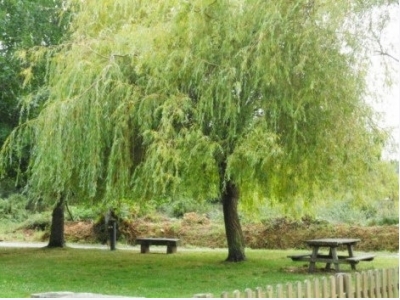How to Grow Weeping Willow Trees

In a wide, sweeping lawn or near a pond or lake, weeping willows make a calming and picturesque addition to the landscape. Unfortunately, they have several liabilities that make them unsuitable for most homeowners.
If, however, you have the right conditions, weeping willows can become an elegant addition to your yard.
Weeping willows (Salix spp.) are native to Asia, but grow extensively throughout the U.S. Hardy in U.S. Department of Agriculture plant hardiness zones 2 through 9, the trees were used by Native Americans who chewed on the twigs to relieve headaches and soreness. The branches contain salicylic acid, the same ingredient found in aspirin.
Planting Weeping Willow Trees
Weeping willow trees can grow to be 45 feet tall and wide, with long, pendulous branches. They need a wide area to grow and should be planted where the long twigs won't interfere with children's play or pedestrian travel. Weeping willows can tolerate most soil types, including alkaline, clay, sand and compacted soil, but they need good drainage. They can grow in full sun to partial shade.
Weeping willows have invasive, shallow roots that can stretch up to three times the length from the trunk to the canopy of the tree. These roots often lie near the surface and can cause bumps in the lawn or even crack cement sidewalks and patios. The roots can also damage underground sewer and plumbing lines.
Plant weeping willow trees by digging a hole as deep as the root ball and twice as wide. Set the tree in the hole and make sure it's straight. Do not add compost, manure or fertilizer to the hole, which will encourage the roots to circle, rather than spreading out. Fill the hole half-full with soil. Add 2 gallons of water and fill the hole with the remaining soil, tamping it down firmly.
Water the tree at least weekly during the first year after planting. Once established, willow trees can tolerate some dryness, although they may drop leaves. They grow best with regular moisture. If your tree is planted in an irrigated lawn, it should get plenty of water.
Weeping willows have a fast growth pattern and can grow more than 24 inches in one year. In a fertilized lawn, weeping willows usually don't need additional fertilizer. Provide ½ cup 10-10-10 fertilizer spread on the lawn under the canopy of the tree in the spring only if growth seems slow or the leaves are pale.
Weeping Willow Pests and Problems
Like most fast-growing trees, weeping willows have brittle wood that's prone to breakage, especially if you live in an area with harsh winters, ice storms and high winds. Prune the tree annually to remove dead or damaged wood, as well as suckers and branches that grow vertically. The long, whip-like branches break easily in the wind and can create a lot of leaf litter.
Weeping willows are afflicted by several pests, including the gypsy moth, aphids and borers. These insects are difficult to control, especially on large trees. Try a spraying program designed for the specific pest that afflicts your tree.
Weeping willows also suffer from several diseases, including willow scab, crown gall, root rot, leaf spots, black canker and rust. These diseases can cause branch or twig dieback, defoliation and in some cases, tree death. Plant disease resistant trees and provide adequate water to keep the tree healthy, since healthy trees are better able to fend off disease. Rake up and remove leaf litter promptly, because disease can rest there.
Because of all these problems, weeping willows are short-lived trees, rarely living more than 50 years. Remember, if you have ideal growing conditions and you're willing to provide the trees with a little extra care, they are beautiful specimens, but they do have more problems than most.
To recap, their issues include:
- Brittle wood and branch breakage
- Invasive roots
- Leaf litter and low lying branches
- Susceptibility to disease and insect pests
- Prefer more water than most trees
Related news
 How to Grow Spiderwort
How to Grow Spiderwort Spiderwort (Tradescantia) is a charming, old-fashioned plant that should be grown more often than it is.
 How to Grow Melampodium (Butter Daisy)
How to Grow Melampodium (Butter Daisy) Melampodium is a bright and carefree annual flower that is not used nearly enough.
 How to Grow Coconut Palm
How to Grow Coconut Palm Few trees are more exotic than the coconut palm (Cocos nucifera Linn.). This regal tree produces edible seeds – coconuts. Unfortunately, coconut palms are hardy